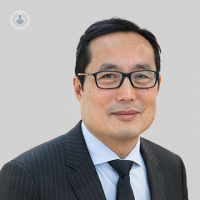An expert’s guide to abdominoplasty
Autore:Pregnancy, rapid or extreme weight loss, and natural ageing can all conspire to cause loose, sagging skin around the belly. However, with the growing popularity of plastic surgery comes a solution: abdominoplasty, also known as a “tummy tuck”. Esteemed plastic surgeon Mr Mark Ho-Asjoe explains:

What does a “tummy tuck” or cosmetic abdominoplasty involve?
Abdominal contouring can either be improved with liposuction alone, a full or mini-abdominoplasty, or a combination of liposuction and abdominoplasty. In general, the patients that benefit from abdominoplasty are those with excessive amount of loose skin, poor-quality skin with stretch marks, and those with abdominal bulge due to separation of the anterior abdominal muscle.
Abdominoplasty surgery usually incorporates a combination of a excising the excess skin and tissue from the lower abdomen, repairing the abdominal bulge by putting the muscle back together, and in some cases additional liposuction to improve the contour. The upper abdominal skin will be pulled downward and the patient will be left with a transverse abdominal scar just above the pubic region and a scar around the umbilicus (belly button).
After the surgery, patients will feel tight in the abdominal region and are advised to wear an abdominal garment for comfort and support. Gentle mobilisation is encouraged but strenuous activities should be avoided for around six weeks.
Can anyone get a tummy tuck?
‘Tummy tuck’ is normally recommended for those patients with excessive fatty tissue and skin in the abdomen.
In patients with moderate abdominal fatty tissue and good quality skin, liposuction can be performed instead of abdominoplasty. In some cases, a mini-abdominoplasty instead of a full abdominoplasty is performed, leaving a short suprapubic scar and no scar around the belly button.
Patients who are heavy smokers have a high risk of skin breakdown due to poor wound healing. Medical issues such as cardiovascular diseases, diabetes, large abdominal hernias, wound healing problems, and those who are on anti-coagulants such as warfarin and aspirin, are at high risk of developing complications and should have a full assessment and consultation. Some patients with excessive abdominal fat may benefit from having a two-stage operation by having liposuction in the first instance, followed by abdominoplasty a few months later.
For those patients contemplating further weight loss or future pregnancy, it may be better to have the surgery after the ideal weight is attained or after giving birth.
What should I expect from the procedure?
Abdominoplasty is ideal for treating patients with excess lower abdominal skin and fatty tissue, and those patients with an abdominal bulge due to separation of the anterior rectus muscle. For those patients with overall excessive abdominal fat or those with fatty tissue bulge in the upper abdomen, having liposuction as a separate operation or at the same time (lesser amount) will significantly improve the final outcome. It is important to understand that this is not a weight loss operation.
Following surgery, there is a scar that runs horizontally across the lower abdomen. The scar should fade within months after the surgery and by following post-operative advice such as using sun block. The skin may be numb for several weeks or even months after the operation (similar to patients who have had a caesarean section) and the area around the incision will feel tight from the removal of the excess skin. Maintaining a healthy lifestyle is important after surgery and it is important to maintain a stable body weight. Ageing will also affect the long-term result.
How safe is a tummy tuck?
As with all surgery, there are risks of wound healing, infection, swelling, bleeding, deep vein thrombosis (DVT), pulmonary embolism (PE), and skin necrosis. The risk of complications is low in general but will increase with certain underlying medical conditions, smoking, and when ‘tummy tuck’ is carried out at the same time with other operations such as breast reduction.
How much does a tummy tuck cost?
The cost of an abdominoplasty will depend upon the type of abdominoplasty and will vary considerably by geographic region. The cost is usually between £6,000 and £8,000, which is inclusive of surgical fee, hospital fee, and anaesthetic fee.


